
Wine Culture and Information since 2002 - Volume 22
 Wine Culture and Information since 2002 - Volume 22 |
|
Contrasts of Cannonau di Sardegna Rosato and Cerasuolo d'Abruzzo SuperioreTwo magnificent red grapes in the rosé interpretation and expression of wines produced in two important wine regions of Italy, mainly known for their whites and reds. |
|
From red berried grapes can be produced not only red wines. With these grapes – as it is well known – can also be produced rosé wines, making use of specific wine making techniques and which, of course, are not used for the production of red wines. In this regard – should there be the need to clarify this aspect – in accordance with the laws in force, the production of rosé wines from the blending of whites and reds is not permitted, except for base wines to be used for the production of rosé sparkling wines. In this specific case, it must however be noted that a rosé sparkling wine is not always the result of the blending of white and red wines, as it is possible to produce it also by starting from a rosé wine, that is exclusively produced with red berried grapes. The enological factor discriminating between a rosé and red wine is notoriously represented by the maceration time of the must with the skins, in which the coloring power of the red berried grapes is contained. It is about decidedly short maceration times, which can vary from a very few hours, rarely beyond twenty. The longer the maceration time, the greater the quantity of coloring substances released from the skins into the must, therefore the more intense the color which will progressively tend from pale pink to red. Finally, it should be noted the production of rosé wines also includes the technique of bleeding – or saignée, as the French say – which consists in taking a fraction of the must in preliminary maceration with skins and intended for the production of a red wine. What is obtained is, in fact, a rosé must which, at the end of fermentation, will become wine. The enological scenario of Italy offers a wide selection of rose wines, a style of wine which in recent years has been attracting good interest from consumers. There are in fact many wine territories in Italy which include rose wines in their production disciplinaries, exactly like the ones we are examining for our tasting by contrast. We will in fact pour into our glasses two rosés belonging to important and renowned denominations: Cannonau di Sardegna Rosato and Cerasuolo d'Abruzzo Superiore.
|
|
When it is about Sardinian wines, one of the first grapes which is most easily associated to the region undeniably is Cannonau. This magnificent variety is widespread throughout the Sardinian territory, and it certainly is the most famous and celebrated one for the island's reds. The wines produced with this grape – in fact –- are recognized by the Italian quality system as Denominazione d'Origine Controllata Cannonau di Sardegna (Denomination of Controlled Origin, DOC). The disciplinary provides for the production of wines in different styles, among these, also rosé, that is the wine we will examine in the tasting by contrast of this month. A style which in recent years has been attracting good interest from producers and, last but not least, from consumers, also due to the greater market demand for this specific style of wine. The production disciplinary of Cannonau di Sardegna, also for the rosé style, provides for the minimum use of 85% of the variety of the same name, while any complementary part can be composed of non-aromatic red berried grapes allowed for cultivation in Sardinia. It is a well known fact Cannonau corresponds to Grenache Noir, or rather, to the Garnacha known in Spain. This variety, in addition to Sardinia, Spain and France, is also found in other wine areas of the world, including various regions of Italy. This analogy has long led to the supposition of the Spanish origin of Cannonau, supporting the hypothesis that it had been introduced to the island in 1400s by the Spaniards. This hypothesis has been denied by some archaeological discoveries conducted in Sardinia, which have allowed the discovery of Cannonau seeds dating back to 3200 years ago. This extraordinary discovery has therefore made it possible to identify Cannonau as a native variety of Sardinia, thus suggesting the reverse journey, that is introduced in Spain and France from this island. This proves, not least, the very long bond of the ancient peoples of Sardinia with viticulture and enology, evidently consolidated and perpetuated up to the present day.
|
||||
|
The enology of Abruzzo is firmly linked to two varieties: Trebbiano d'Abruzzo for the whites, Montepulciano for the reds and, of course, rosés. In fact, when one thinks of the wines of this region, the association with these two grapes and related wines is practically inevitable. Both varieties are the basis of the main and historical Denominazione d'Origine Controllata wines of the region: Trebbiano d'Abruzzo and Montepulciano d'Abruzzo. To these we must add Cerasuolo which, until a few years ago, was in fact included in the production disciplinary of the great red wine of the region, whereas today it is properly recognized with its own denomination. At the basis of this historic rosé wine from Abruzzo, we find the Montepulciano variety, which must be present – according to the production disciplinary – for a minimum of 85%. The remaining part, as often happens for almost all Italian DOC wines, is possibly made up of non-aromatic red berried grapes and permitted for cultivation in the region. The production disciplinary of this wine also provides for the superiore style – and this is what we examine in our tasting – which is characterized by the higher alcohol content and the possibility of aging in wooden containers. Cerasuolo d'Abruzzo certainly is among the most famous rosé wines of Italy and has a long tradition, without a shadow of a doubt among the most versatile rosés in food and wine pairing. Thanks to the Montepulciano grape, Cerasuolo d'Abruzzo can express singular and different characters, from light and immediate wines, to structured and robust interpretations. To this must also be added the possibility of aging in wood for the “superiore” style which, when used, gives Cerasuolo d'Abruzzo organoleptic power and complexity. In this regard, it should be noted the aging of this wine in wood is pretty rare and the majority of producers prefer the use of inert containers, in order to better enhance the crispness and immediacy of the wine.
|
Let's proceed with getting the two bottles we will pour into the glasses for our tasting by contrast. At this time, it is about two wines which are very common, therefore it will not be difficult to find them in any good wine shop. For both wines, we need to be careful in choosing bottles which have been produced with the respective varietals alone. This aspect is very important as the production disciplinary of Cannonau di Sardegna Rosato and Cerasuolo d'Abruzzo Superiore allow the use of at least 85% of the primary variety. As far as wine making practices are concerned, we will make sure the two wines have been fermented and aged in inert containers, preferably steel tanks. This allows, in fact, to better appreciate the qualities of the two grapes and, in particular, the crispness of the rosés. The two wines belong to the most recent vintage and are poured into their respective glasses at a temperature of 12 °C. (54 °F) The first sensorial characteristic we will examine is appearance, therefore how wines are seen by our eyes in terms of color and transparency. Let's start by observing the glass of Cannonau di Sardegna Rosato and – by tilting the glass over a white surface – let's pay attention to the base, where the thickness of the wine is greatest. It can be observed a cherry pink color of medium intensity and transparency – evaluated by placing an object in contrast between the white surface and the glass – is decidedly high. Let's now proceed with the evaluation of nuances, therefore let's pay attention to the opening of the glass, where the wine becomes thin. The nuance of Cannonau di Sardegna Rosato confirms its base color. Let's move on to the evaluation of the appearance of Cerasuolo d'Abruzzo Superiore, starting from color and transparency. By observing the wine at the base of the glass, we notice a decidedly intense cherry pink color, generally much more than the Sardinian wine, with a high transparency, however lower than that of the previous wine. The nuance of Cerasuolo d'Abruzzo Superiore confirms the base color. The olfactory profiles of Cannonau and Montepulciano are extremely different, not only when comparing their interpretations of red wines. These differences are also evident in rosé vinifications, for which the maceration time with the skins becomes a further discriminating factor. In this regard, it should however be noted the olfactory differences between Cannonau and Montepulciano are decidedly more evident and distant especially in red wines, whereas in rosé ones they become more subtle and less varied. In both cases, in their interpretations in rosé, are mainly perceived aromas of flowers with pink or red petals – such as cyclamen and rose – however in those produced with Montepulciano it is not uncommon to perceive violet as well. The world of fruits of Cannonau and Montepulciano vinified in rosé is strongly characterized by red pulp fruits, often also dark, which are sometimes combined with peach and pleasing hints of citrus fruits, in particular tangerine. Let's continue this month's tasting by contrast and proceed with the analysis of the olfactory profiles of Cannonau di Sardegna Rosato and Cerasuolo d'Abruzzo Superiore, starting – as in the previous phase – from the Sardinian wine. Let's hold the glass in vertical position and, without swirling, do the first smell in order to appreciate the opening of the wine, that is the evaluation of its primary and identifying aromas. From the glass are perceived clean and pleasing notes of cyclamen followed by aromas of cherry, raspberry and strawberry. Let's now swirl the glass and proceed with the second smell, therefore evaluating the remaining aromas of the wine. From the glass we can now appreciate aromas of rose, blueberry, plum and hints of peach. Let's move on to the evaluation of the olfactory profile of Cerasuolo d'Abruzzo Superiore, therefore by holding the glass in vertical position, let's proceed with the analysis of the opening. The nose perceives intense and clean aromas of cyclamen followed by cherry, blueberry and raspberry. After having swirled the glass and carried out the second smell, the olfactory profile of the wine from Abruzzo is completed with dog rose and violet as well as fruit aromas in which we recognize blackberry, plum and pomegranate, often followed by tangerine. Finally, in this wine, it can sometimes be perceived aromas of almond. Let's now pass to the evaluation of the gustatory profiles of the wines of our tasting by contrast and – as in the previous phases – let's start with the Cannonau di Sardegna Rosato. Let's therefore take a sip of this wine in order to evaluate its attack, that is the initial and identifying gustatory sensations. The first sensation we perceive in the mouth is the crispness given by acidity and which finds its balance in the effect of alcohol. It can also be perceived a slight sensation of astringency and a medium body structure. In the mouth are clearly perceived the flavors of cherry, raspberry and strawberry, therefore confirming a good correspondence to the nose. Let's move on to the evaluation of the attack of Cerasuolo d'Abruzzo Superiore, take a sip and focus on the sensations perceived in the mouth. The wine from Abruzzo can be appreciated for its pleasing crispness which is often combined with a good alcohol volume – useful for reaching balance – as well as the sensation of good structure, generally fuller than Cannonau di Sardegna Rosato. In this wine can also be appreciated a slight astringency, as well as flavors of cherry, raspberry and blueberry,therefore having a good correspondence to the nose. We have reached the end of this month's tasting by contrast, therefore let's proceed with the evaluation of the final sensations the two wines leave in the mouth after swallowing, in particular the taste-olfactory persistence. The finish of Cannonau di Sardegna Rosato is persistent and in the mouth are still perceived both the pleasing crispness given by acidity and the pseudo-burning effect of alcohol, well supported by the good structure. We can also clearly perceive the flavors of cherry, raspberry and strawberry. The finish of Cerasuolo d'Abruzzo Superiore is certainly persistent and, also in this case, the crispness given by acidity is clearly perceived as well as the pseudo-burning sensation produced by the alcohol which, in the superiore style, plays a determinant role. The sensation of structure is decidedly well perceptible and generally fuller than Cannonau di Sardegna Rosato. In the mouth we also continue to perceive the flavors of cherry, raspberry and blueberry, frequently followed by blackberry. Before concluding the tasting, let's do a final analysis of the olfactory profiles, first the Cannonau di Sardegna Rosato and then the Cerasuolo d'Abruzzo Superiore: the differences are still well distinct and evident.
|
||||||||
Wines of the Month |
|
|
|
Score legend Prices are to be considered as indicative. Prices may vary according to the country or the shop where wines are bought |
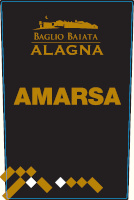
|
|
Amarsa |
|
| Alagna (Sicily, Italy) | |
 Grillo, Catarratto, Inzolia Grillo, Catarratto, Inzolia | |
| Price: € 12.50 | Score: |
 Intense mahogany and nuances of mahogany, little transparency. Intense mahogany and nuances of mahogany, little transparency. Intense, clean, pleasing and refined, starts with hints of citrus fruit
peel and gentian followed by aromas of orange, caramel, vanilla and almond. Intense, clean, pleasing and refined, starts with hints of citrus fruit
peel and gentian followed by aromas of orange, caramel, vanilla and almond.
 Sweet and round attack, however balanced by alcohol, good body, intense
flavors, pleasing bitter touch. Sweet and round attack, however balanced by alcohol, good body, intense
flavors, pleasing bitter touch.
 Persistent finish with flavors of gentian, orange and caramel. Persistent finish with flavors of gentian, orange and caramel. Produced with Marsala Fine and added flavoring. Produced with Marsala Fine and added flavoring. |
|
 Dried fruit tarts, Confectionery Dried fruit tarts, Confectionery |
|
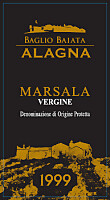
|
|
Marsala Vergine Baglio Baiata 1999 |
|
| Alagna (Sicily, Italy) | |
 Grillo, Catarratto Grillo, Catarratto | |
| Price: € 26.50 | Score: |
 Intense amber yellow and nuances of amber yellow, moderate
transparency. Intense amber yellow and nuances of amber yellow, moderate
transparency.
 Intense, clean, pleasing and refined, starts with hints of rancho,
dried fig and citrus fruit peel followed by aromas of date, hazelnut,
honey, almond, licorice, leather and vanilla. Intense, clean, pleasing and refined, starts with hints of rancho,
dried fig and citrus fruit peel followed by aromas of date, hazelnut,
honey, almond, licorice, leather and vanilla.
 Crisp attack and however balanced by alcohol, full body, intense
flavors, pleasing roundness. Crisp attack and however balanced by alcohol, full body, intense
flavors, pleasing roundness.
 Persistent finish with flavors of dried fig, hazelnut and honey. Persistent finish with flavors of dried fig, hazelnut and honey. Aged in cask. Aged in cask. |
|
 Aperitifs, Hard and piquant cheese Aperitifs, Hard and piquant cheese |
|
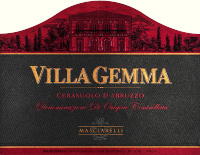
|
|
Cerasuolo d'Abruzzo Superiore Villa Gemma 2021 |
|
| Masciarelli (Abruzzo, Italy) | |
 Montepulciano Montepulciano | |
| Price: € 15.10 | Score: |
 Intense cherry pink and nuances of cherry pink, moderate transparency. Intense cherry pink and nuances of cherry pink, moderate transparency. Intense, clean, pleasing, refined and elegant, starts with hints of
cherry, raspberry and rose followed by aromas of cyclamen, strawberry,
pomegranate, blueberry, blackberry, plum, apple and peach. Intense, clean, pleasing, refined and elegant, starts with hints of
cherry, raspberry and rose followed by aromas of cyclamen, strawberry,
pomegranate, blueberry, blackberry, plum, apple and peach.
 Crisp attack and however balanced by alcohol, good body, intense
flavors, agreeable. Crisp attack and however balanced by alcohol, good body, intense
flavors, agreeable.
 Persistent finish with flavors of cherry, raspberry and strawberry. Persistent finish with flavors of cherry, raspberry and strawberry. 3 months in steel tanks. 3 months in steel tanks. |
|
 Pasta with meat, Roasted fish, Broiled fish, Roasted white meat, Dairy products, Legume soups Pasta with meat, Roasted fish, Broiled fish, Roasted white meat, Dairy products, Legume soups |
|
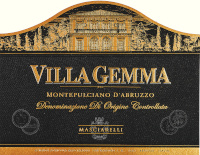
|
|
Montepulciano d'Abruzzo Riserva Villa Gemma 2017 |
|
| Masciarelli (Abruzzo, Italy) | |
 Montepulciano Montepulciano | |
| Price: € 61.00 | Score: |
 Deep ruby red and nuances of garnet red, impenetrable to light. Deep ruby red and nuances of garnet red, impenetrable to light. Intense, clean, pleasing, refined and elegant, starts with hints fo
plum, black cherry and blueberry followed by aromas of dried violet, peony,
blackberry, cocoa, carob, tobacco, cinnamon, licorice, leather, mace,
graphite, vanilla and menthol. Intense, clean, pleasing, refined and elegant, starts with hints fo
plum, black cherry and blueberry followed by aromas of dried violet, peony,
blackberry, cocoa, carob, tobacco, cinnamon, licorice, leather, mace,
graphite, vanilla and menthol.
 Properly tannic attack and however balanced by alcohol, full body,
intense flavors, pleasing roundness. Properly tannic attack and however balanced by alcohol, full body,
intense flavors, pleasing roundness.
 Very persistent finish with long flavors of plum, black cherry and
blueberry. Very persistent finish with long flavors of plum, black cherry and
blueberry.
 18 months in barrique, at least 24 months in bottle. 18 months in barrique, at least 24 months in bottle. |
|
 Game, Roasted meat, Stewed and braised meat, Hard cheese Game, Roasted meat, Stewed and braised meat, Hard cheese |
|
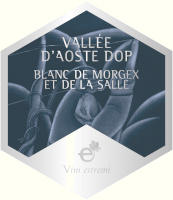
|
|
Valle d'Aosta Blanc de Morgex et de La Salle Vini Estremi 2021 |
|
| Cave Mont Blanc de Morgex et La Salle (Vallée d'Aoste, Italy) | |
 Prié Blanc Prié Blanc | |
| Price: € 15.00 | Score: |
 Brilliant greenish yellow and nuances of greenish yellow, very
transparent. Brilliant greenish yellow and nuances of greenish yellow, very
transparent.
 Intense, clean, pleasing and refined, starts with hints of peach, pear
and pineapple followed by aromas of wisteria, broom, hawthorn, lemon, green
apple, kiwi, almond and mineral. Intense, clean, pleasing and refined, starts with hints of peach, pear
and pineapple followed by aromas of wisteria, broom, hawthorn, lemon, green
apple, kiwi, almond and mineral.
 Crisp attack and however balanced by alcohol, light body, intense
flavors, agreeable. Crisp attack and however balanced by alcohol, light body, intense
flavors, agreeable.
 Persistent finish with flavors of peach, pineapple and lemon. Persistent finish with flavors of peach, pineapple and lemon. Aged in steel tanks. Aged in steel tanks. |
|
 Vegetable and crustacean appetizers, Risotto with vegetables and crustaceans, Sauteed crustaceans, Eggs Vegetable and crustacean appetizers, Risotto with vegetables and crustaceans, Sauteed crustaceans, Eggs |
|
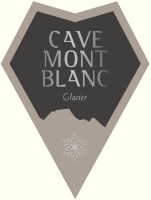
|
|
Valle d'Aosta Blanc de Morgex et de La Salle Metodo Classico Pas Dosé Glacier 2019 |
|
| Cave Mont Blanc de Morgex et La Salle (Vallée d'Aoste, Italy) | |
 Prié Blanc Prié Blanc | |
| Price: € 24.00 | Score: |
 Brilliant straw yellow and nuances of straw yellow, very transparent. Brilliant straw yellow and nuances of straw yellow, very transparent. Intense, clean, pleasing and refined, starts with hints of green apple,
citrus fruits and bread crust followed by aromas of hawthorn, wisteria,
jasmine, pear, kiwi, peach, mineral and hints of vanilla. Intense, clean, pleasing and refined, starts with hints of green apple,
citrus fruits and bread crust followed by aromas of hawthorn, wisteria,
jasmine, pear, kiwi, peach, mineral and hints of vanilla.
 Crisp and effervescent attack, however balanced by alcohol, good body,
intense flavors, agreeable. Crisp and effervescent attack, however balanced by alcohol, good body,
intense flavors, agreeable.
 Persistent finish with flavors of green apple, pear and kiwi. Persistent finish with flavors of green apple, pear and kiwi. The base wine ferments part in cask and part in steel tanks.
Refermented in bottle and aged on its lees for at least 24 months. The base wine ferments part in cask and part in steel tanks.
Refermented in bottle and aged on its lees for at least 24 months.
|
|
 Pasta and risotto with fish and crustaceans, Sauteed fish, Broiled crustaceans, Dairy products Pasta and risotto with fish and crustaceans, Sauteed fish, Broiled crustaceans, Dairy products |
|
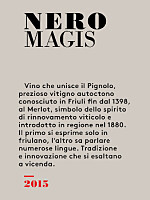
|
|
Friuli Colli Orientali Rosso Nero Magis 2015 |
|
| Magis (Friuli-Venezia Giulia, Italy) | |
 Merlot (60%), Pignolo (40%) Merlot (60%), Pignolo (40%) | |
| Price: € 35.90 | Score: |
 Intense ruby red and nuances of garnet red, little transparency. Intense ruby red and nuances of garnet red, little transparency. Intense, clean, pleasing, refined and elegant, starts with hints of
black currant, black cherry and plum followed by aromas of violet, peony,
blueberry, cocoa, tobacco, sandal wood, licorice, leather, mace, vanilla
and eucalyptus. Intense, clean, pleasing, refined and elegant, starts with hints of
black currant, black cherry and plum followed by aromas of violet, peony,
blueberry, cocoa, tobacco, sandal wood, licorice, leather, mace, vanilla
and eucalyptus.
 Properly tannic attack and however balanced by alcohol, good body,
intense flavors, agreeable. Properly tannic attack and however balanced by alcohol, good body,
intense flavors, agreeable.
 Very persistent finish with long flavors of black currant, black cherry
and plum. Very persistent finish with long flavors of black currant, black cherry
and plum.
 24 months in bottle. 24 months in bottle. |
|
 Roasted meat, Stewed meat with mushrooms, Broiled meat and barbecue, Cheese Roasted meat, Stewed meat with mushrooms, Broiled meat and barbecue, Cheese |
|
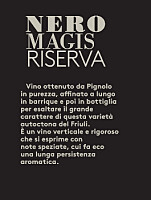
|
|
Friuli Colli Orientali Rosso Riserva Nero Magis 2016 |
|
| Magis (Friuli-Venezia Giulia, Italy) | |
 Pignolo Pignolo | |
| Price: € 49.00 | Score: |
 Deep ruby red and and nuances of garnet red, little transparency. Deep ruby red and and nuances of garnet red, little transparency. Intense, clean, pleasing, refined and elegant, starts with hints of
black cherry, plum and dried violet followed by aromas of peony,
blackberry, blueberry, cocoa, tobacco, lavender, cinnamon, face powder,
licorice, leather, mace, vanilla and menthol. Intense, clean, pleasing, refined and elegant, starts with hints of
black cherry, plum and dried violet followed by aromas of peony,
blackberry, blueberry, cocoa, tobacco, lavender, cinnamon, face powder,
licorice, leather, mace, vanilla and menthol.
 Properly tannic attack and however balanced by alcohol, full body,
intense flavors, pleasing crispness. Properly tannic attack and however balanced by alcohol, full body,
intense flavors, pleasing crispness.
 Very persistent finish with long flavors of plum, black cherry and
blackberry. Very persistent finish with long flavors of plum, black cherry and
blackberry.
 At least 24 months in barrique, at least 18 months in bottle. At least 24 months in barrique, at least 18 months in bottle. |
|
 Game, Stewed and braised meat with mushrooms, Roasted meat, Hard cheese Game, Stewed and braised meat with mushrooms, Roasted meat, Hard cheese |
|
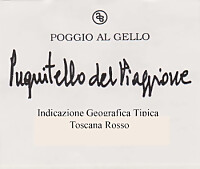
|
|
Pugnitello del Piaggione 2020 |
|
| Poggio al Gello (Tuscany, Italy) | |
 Pugnitello Pugnitello | |
| Price: € 22.00 | Score: |
 Intense ruby red and nuances of ruby red, little transparency. Intense ruby red and nuances of ruby red, little transparency. Intense, clean, pleasing and refined, starts with hints of black
cherry, black currant and plum followed by aromas of violet, blueberry,
blackberry, chocolate, black pepper, graphite and vanilla. Intense, clean, pleasing and refined, starts with hints of black
cherry, black currant and plum followed by aromas of violet, blueberry,
blackberry, chocolate, black pepper, graphite and vanilla.
 Properly tannic attack and however balanced by alcohol, good body,
intense flavors, agreeable. Properly tannic attack and however balanced by alcohol, good body,
intense flavors, agreeable.
 Persistent finish with flavors of black cherry, black currant and plum. Persistent finish with flavors of black cherry, black currant and plum. 12 months in barrique, 6 months in bottle. 12 months in barrique, 6 months in bottle. |
|
 Broiled meat and barbecue, Roasted meat, Stewed meat with mushrooms, Cheese Broiled meat and barbecue, Roasted meat, Stewed meat with mushrooms, Cheese |
|
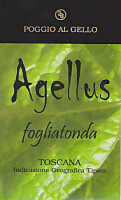
|
|
Agellus 2018 |
|
| Poggio al Gello (Tuscany, Italy) | |
 Foglia Tonda Foglia Tonda | |
| Price: € 25.00 | Score: |
 Intense ruby red and nuances of garnet red, little transparency. Intense ruby red and nuances of garnet red, little transparency. Intense, clean, pleasing, refined and elegant, starts with hints of
plum, black cherry and blackberry followed by aromas of dried violet,
blueberry, carob, cocoa, tobacco, licorice, leather, graphite, vanilla and
menthol. Intense, clean, pleasing, refined and elegant, starts with hints of
plum, black cherry and blackberry followed by aromas of dried violet,
blueberry, carob, cocoa, tobacco, licorice, leather, graphite, vanilla and
menthol.
 Properly tannic attack and however balanced by alcohol, good body,
intense flavors, pleasing roundness. Properly tannic attack and however balanced by alcohol, good body,
intense flavors, pleasing roundness.
 Persistent finish with flavors of plum, black cherry and blackberry. Persistent finish with flavors of plum, black cherry and blackberry. 12 months in barrique, 6 months in bottle. 12 months in barrique, 6 months in bottle. |
|
 Broiled meat and barbecue, Stewed meat with mushrooms, Roasted meat, Cheese Broiled meat and barbecue, Stewed meat with mushrooms, Roasted meat, Cheese |
|
|
||||||||
|
DiWineTaste Polls
|
| |||||||
Privacy Policy | |||||||


| Copyright © 2002-2024 Antonello Biancalana, DiWineTaste - All rights reserved |
| All rights reserved under international copyright conventions. No part of this publication and of this WEB site may be
reproduced or utilized in any form or by any means, electronic or mechanical, without permission in writing from DiWineTaste. |